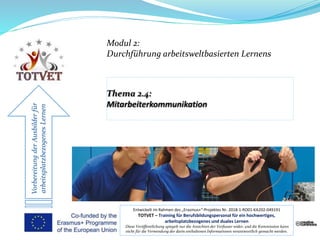
Learning tool M2_T4_Interpersonal communication and empathy
- 1. VorbereitungderAusbilderfür arbeitsplatzbezogenesLernen Modul 2: Durchführung arbeitsweltbasierten Lernens Entwickelt im Rahmen des „Erasmus+“-Projektes Nr. 2018-1-RO01-KA202-049191 TOTVET – Training für Berufsbildungspersonal für ein hochwertiges, arbeitsplatzbezogenes und duales Lernen Diese Veröffentlichung spiegelt nur die Ansichten der Verfasser wider, und die Kommission kann nicht für die Verwendung der darin enthaltenen Informationen verantwortlich gemacht werden.
- 2. Zusammenfassung Mit Hilfe dieser Lerneinheit werden Sie sich mit der verbalen und nonverbalen Kommunikation vertraut machen, die Rolle der sozialen Kommunikation und die Kunst des Zuhörens verstehen und in der Lage sein, Ihre eigene Selbstpräsentation vorzubereiten. Die behandelten Hauptpunkte sind: Die Rolle der sozialen Kommunikation im menschlichen Leben Nonverbale Kommunikation Verbale Kommunikation, die Rolle des Zuhörens und der Barrieren für die Kommunikation Die Rolle und Methoden der Selbstpräsentation Selbstpräsentation – Übungen Empathie – die Kunst des Zuhörens
- 3. Die Rolle der sozialen Kommunikation im menschlichen Leben Die Kommunikation ist ein Prozess des Sendens und Empfangens von Informationen unter Menschen. Viele Menschen glauben, dass die Bedeutung der Kommunikation so groß wie die Bedeutung der Atmung ist. Tatsächlich erleichtert die Kommunikation die Verbreitung von Wissen und schafft Beziehungen zwischen Menschen.
- 4. Die Ebenen der sozialen Kommunikation Die Ebenen der Kommunikation: Intrapersonale Kommunikation Zwischenmenschliche Kommunikation Gruppenkommunikation Massenkommunikation Extrapersonale Kommunikation https://pixabay.com/pl/photos/
- 5. Intrapersonale Kommunikation kann als Kommunikation mit sich selbst definiert werden, und das kann Selbstgespräche, Handlungen der Vorstellungskraft und Visualisierung, ja sogar Erinnerungen und Gedächtnis beinhalten. https://pixabay.com/pl/photos/ Zwischenmenschliche (interpersonale) Kommunikation ist ein Prozess, bei dem Menschen Informationen, Gefühle und Meinungen durch verbale und nonverbale Botschaften untereinander austauschen. Die Ebenen der sozialen Kommunikation
- 6. Die Kommunikation zwischen Menschen und nicht-menschlichen Wesen wird als extrapersonale Kommunikation bezeichnet. https://pixabay.com/pl/photos/ Kommunikation in einer Kleingruppe bezieht sich auf Interaktionen zwischen drei oder mehr Personen, die durch ein gemeinsames Ziel, gegenseitige Beeinflussung und eine gemeinsame Identität miteinander verbunden sind. Die Ebenen der sozialen Kommunikation
- 7. Massenkommunikation ist ein Prozess, in dem die Informationen über Massenmedien an große Teile der Bevölkerung verbreitet werden. Die Ebenen der sozialen Kommunikation
- 8. Verbale und nonverbale Kommunikation Schauen Sie sich das (englischsprachige) Video „Verbale vs. nonverbale Kommunikation: Unterschied zwischen ihnen mit Beispielen und Vergleichstabelle“ an: https://www.youtube.com/watch?v=akfatVK5h3Y
- 9. Verbale und nonverbale Kommunikation spielen eine wichtige Rolle bei der Art und Weise, wie Menschen miteinander umgehen. Elemente der persönlichen Kommunikation: • 7% - gesprochene Wörter • 38% - Stimme, Ton • 55% - Körpersprache Verbale und nonverbale Kommunikation
- 10. Nonverbale Kommunikation Nonverbale Kommunikation ist ein Prozess des Sendens und Empfangens von Botschaften ohne Verwendung von Wörtern, sowohl gesprochen als auch geschrieben. Sie wird auch als „außersprachlich“ bezeichnet.
- 11. Lesen Sie den (englischsprachigen) Text „Arten der nonverbalen Kommunikation“ unter: https://www.verywellmind.com/types-of-nonverbal- communication-2795397 und schauen Sie sich das Video „9 Arten der nonverbalen Kommunikation“ auf der gleichen Webseite an. https://pixabay.com/pl/photos/ Nonverbale Kommunikation
- 12. Verbale Kommunikation ist die Verwendung von Wörtern, um Informationen mit anderen Menschen zu teilen. Verbale Kommunikation
- 13. Lesen Sie die (englischsprachigen) Texte: „Liste der verbalen Kommunikationsfähigkeiten mit Beispielen” https://www.thebalancecareers.com/verbal-communication-skills-list- 2059698 „Fähigkeit des Zuhörens” https://www.skillsyouneed.com/ips/listening-skills.html und schauen Sie sich folgende Videos an: „Bedeutung der Fähigkeit des effektiven Zuhörens” https://www.youtube.com/watch?v=2qo1aa0TEWc „Kommunikationsbarrieren, Begriff, Natur, Wichtigkeit und Prozess der Kommunikation” https://www.youtube.com/watch?v=T_eel0OYU4k Verbale Kommunikation
- 14. Die Rolle und Methoden der Selbstpräsentation Selbstpräsentation ist ein Prozess der Selbstkontrolle des Einzelnen, wie er von seinem Umfeld wahrgenommen wird. Selbstpräsentation (in der Psychologie) – die Art und Weise, wie jeder Mensch durch seine Aussagen, Verhaltensweisen und nonverbalen Signale nach außen kommuniziert, wer er ist oder wer er sein möchte.
- 15. Schauen Sie sich einige (englischsprachige) Videos an: „Denken Sie schnell. Sprechen Sie smart“ von Matt Abrahams / TEDxMontaVistaHighSchool https://www.youtube.com/watch?time_continue=1&v=o3K_HbpW Npg „Körpersprache. Die Kraft liegt in Ihren Händen” von Allan Pease / TEDxMacquarieUniversity https://www.youtube.com/watch?time_continue=3&v=ZZZ7k8cM A-4 „Das überraschende Geheimnis des selbstbewussten Sprechens” von Caroline Goyder / TEDxBrixton https://www.youtube.com/watch?v=a2MR5XbJtXU Die Rolle und Methoden der Selbstpräsentation
- 16. Selbstpräsentation – Übungen Schauen Sie sich folgende (englischsprachige) Videos an: „Wie man reden soll, damit die Menschen zuhören wollen“ von Julian Treasure Https://www.youtube.com/watch?time_continue=10&v=eIho2S0ZahI „Reden Sie wie ein Leader“ von Simon Lancaster / TEDxVerona https://www.youtube.com/watch?v=bGBamfWasNQ Und… Nehmen Sie eine 1-minütige Rede auf, in der Sie sich selbst und das von Ihnen geführte Meeting vorstellen, und stellen Sie sie anschließend den anderen Teilnehmern, die sie auswerten sollen, zur Verfügung.
- 17. Empathie – die Kunst des Zuhörens Empathie ist die Fähigkeit, Emotionen zu verstehen und sich auf Emotionen zu beziehen. Menschen mit Empathie verstehen andere Menschen und können von anderen als die „warme und angenehme“ Art von Menschen angesehen werden. Das folgende Quiz misst Ihr Empathie-Niveau, indem es verschiedene Arten von Fragen stellt. Sie werden nach Ihrem Verhalten, Ihren Überzeugungen und danach, was Sie in imaginären Situationen tun würden, gefragt. Das Empathie-Quiz: https://www.gotoquiz.com/the_empathy_test
- 18. Schauen Sie sich einige (englischsprachige) Videos über die Fähigkeit des einfühlsamen Zuhörens an: „Entwicklung der Fähigkeit des einfühlsamen Zuhörens“ https://www.youtube.com/watch?v=99QI1yZzRyY „Video über einfühlsames Zuhören“ https://www.youtube.com/watch?v=0766jUAtaU8 Empathie – die Kunst des Zuhörens
- 19. Vielen Dank für die effektive Arbeit!